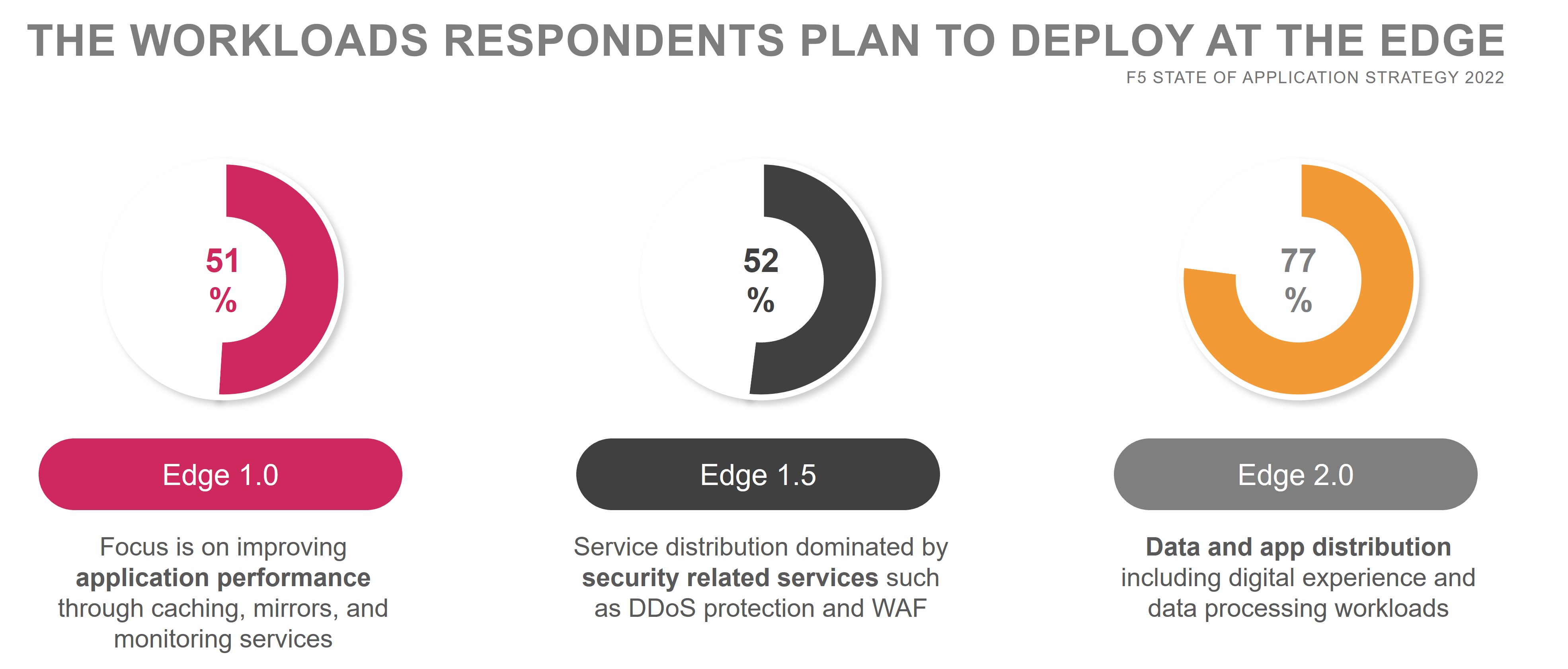État de la stratégie application 2022 : Les charges de travail Edge s'étendent aux applications et aux données
Edge continue d'être passionnant alors qu'il émerge du monde trouble du battage médiatique. La forme du bord commence à prendre forme à mesure que la perception de ce que le bord peut faire mûrit.
Et cette perception mûrit rapidement, avec une évolution significative vers la vision de l'edge comme une plate-forme de distribution application capable de répondre à la préoccupation principale des entreprises numériques d'aujourd'hui : les performances .
Prenant en charge à la fois de meilleures performances pour les services numériques (applications et API) et les services sensibles à la latence, l'edge computing émergent est définitivement une cible pour un nombre important d'organisations.
La priorisation des cas d'utilisation place en premier non la performance directe, mais une cause majeure de ses problèmes : la collecte, le traitement et l’analyse des données.

La capacité de déployer des charges de travail liées aux données en périphérie n’est pas aussi simple que de supprimer du contenu statique ou de mettre en place des services de sécurité. Il n’est pas non plus simple de déployer les charges de travail des application prenant en charge les expériences numériques, telles que les interfaces Web. Les deux nécessitent une plateforme plus robuste que celle disponible avec les plateformes Edge traditionnelles (CDN).
Et bien que ces plateformes soient naissantes, il existe une demande claire pour elles sur le marché.

Plus des trois quarts des répondants prévoient de déployer des charges de travail de distribution de données et d’applications en périphérie . Ces plans ne seront vains sans une plateforme capable de prendre en charge le développement, le déploiement et l’exploitation de ces charges de travail.
Cette plateforme est nécessaire car Edge introduit de nouveaux modèles application qui tirent parti de la proximité de ses utilisateurs, qu’ils soient humains, machines ou logiciels. Cela est rendu plus difficile par le fait que ces modèles reposent également sur le déploiement de charges de travail dans le cœur et le cloud.
De nouveaux modèles émergent
Les modèles application Edge sont uniques car ils se concentrent non seulement sur les modèles d’interaction, mais incluent également le flux de données et le contrôle. En ce sens, ils constituent l’un des premiers modèles application à réunir à la fois les exigences IT (Information Technology) et OT (Operational Technology).
Par exemple, le terme « données » dans les architectures application fait généralement référence aux données liées à l’entreprise. Informations client, catalogues de produits et même historiques de commandes/facturations. Mais à mesure que la technologie s’étend jusqu’à la périphérie, les données opérationnelles deviennent un composant de l’architecture . La configuration et les politiques, par exemple, sont des constructions de données uniques qui doivent être prises en compte dans les décisions architecturales.
Une catégorie de données de plus en plus importante est la télémétrie : les données générées par les systèmes, les plateformes, les appareils et les applications sur leur état. Cela inclut le statut, les erreurs, les performances et d’autres détails opérationnels.
Mais vous remarquerez que les charges de travail application et de données prévues pour la périphérie ne sont qu’un sous-ensemble de celles nécessaires pour fournir des services numériques au marché. Un pourcentage important d’un service numérique est pris en charge par des charges de travail application traditionnelles et modernes représentant de nombreuses fonctions différentes : gestion de compte, traitement des commandes, méthodes de paiement, accords juridiques, etc. Ces charges de travail ne sont pas considérées comme des charges de travail « périphériques », mais resteront plutôt dans des environnements principaux ou cloud .
La réalité des applications couvrant les plates-formes principales, cloud et périphériques peut expliquer une relation intéressante entre l'ingénierie de fiabilité du site et de la périphérie (SRE). Les pratiques SRE sont fortement corrélées à des opérations de type cloud qui améliorent l’efficacité, la rapidité et l’échelle de livraison. Une plateforme de périphérie devra être de type cloud dans sa capacité à prendre en charge le même style d’opérations. D'après nos recherches, il semble y avoir une corrélation entre SRE et Edge, ce qui suggère que l'adoption de pratiques SRE place les organisations dans un « état prêt » pour récolter les avantages associés à edge computing.

Tous les signes indiquent la nécessité d'une plateforme Edge 2.0
Qu'il s'agisse des charges de travail prévues pour la périphérie ou du flux de données produisant un nouvel ensemble de modèles application , tous les signes montrent la nécessité d'une plate-forme Edge 2.0 axée sur les capacités de distribution application et de données.
Cette plateforme adopte les qualités du cloud grâce à son élasticité logicielle pour les ressources d'infrastructure et réseau. Elle se concentre sur les applications et s'intègre parfaitement aux outils du cycle de vie applicatif. Elle prend en charge la sécurité distribuée ainsi que le traitement et l'analyse des données. Elle valorise l'expérience des opérations en fournissant aux SRE l'observabilité nécessaire pour automatiser et optimiser la livraison via une automatisation et un plan de contrôle unifié.
Cette plateforme n'existe pas encore. Mais les données de cette année montrent une demande qui va conduire à la création d’un tel système.
Bienvenue dans l’ère Edge 2.0 !
Consultez des blogs supplémentaires pour des analyses plus approfondies sur certains sujets :
État de la stratégie d'application 2022 : Déballage de 8 années de tendances ›
État de la stratégie d'application 2022 : La sécurité se transforme en identité ›
État de la stratégie d'application 2022 : La complexité du multi-cloud perdure ›
État de la stratégie d'application 2022 : Tendances de performance ›
État de la stratégie d'application 2022 : Il est temps de moderniser les opérations ›
État de la stratégie d'application 2022 : L’avenir des entreprises est adaptatif ›
